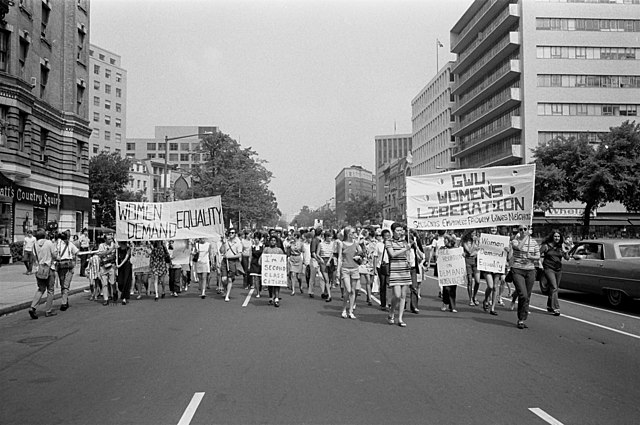Recommended
This piece is the fifth in the series “Episodes in the Life of an American, Woman, Development Economist.” Future episodes will be posted over the coming months.
To join the mailing list for future episodes, fill out this form or contact nancy'slife@cgdev.org.
Before I get to the origin of CGD I want to say something about the concept of “mission.” I attended Catholic schools straight through college, and though before I left college I had left behind being a Catholic, I had apparently internalized the idea of having a mission in life—as in the missionaries who traveled to “poor countries to save people’s souls.” In retrospect, a mission of saving souls in the colonies and former colonies leaves a bad taste of condescension and paternalism. But the idea of having a mission or a purpose in life beyond one’s own health and wealth seems right to me.
Perhaps it is not a coincidence that staff at the multilateral development banks still go on “missions” when they travel to borrowing countries; might that also leave a bitter taste some decades from now?
This episode is about how I “found” the mission of the Center for Global Development – a development mission that is different from that carried out by staff at USAID, and the UK’s FCDO, and the World Bank and the IMF, and different from that addressed in the work of many of the world’s finest development scholars as well.[1]
At the end of episode 4 in this series, I’d become the executive vice president at the Inter-American Development Bank, benefiting from “exorbitant” American privilege. I spent five years (1993-1998) at the IDB and savor every bit of it still; my experiences at the IDB are grist for a future episode on juggling the mix of “Washington Consensus” neoliberalism and inequality reduction that characterized the IDB approach in the 1990s.[2] When I resigned, I was sorry to give up the associated “rights and privileges” of high office in a big multilateral development bank.[3] But I had spent a lot of time away from home and had often worked late. By 1998 that oldest daughter who visited the Amazon with me (also episode 4) was finishing college, and I had learned that when privileged children go off to college, they don’t come home again in the true sense, not even in the summer; they return only as short-term visitors. So, still bereft at her departure, I resolved to see more of our two younger children, in 1998 ages 15 and 12, if only for dinner most nights, and especially more of our 15-year-old daughter, suddenly just two years away from leaving too.
So I accepted a new job as senior fellow at a top-rate Washington think tank, the Carnegie Endowment for International Peace, agreeing to a big drop in salary, which a working husband and the accumulated wealth of early privilege made easy. To be honest, that decision was more out of personal indulgence than any sense that the children needed mom at the dinner table. I had not worried that my children weren’t seeing enough of me because of the demands of work; I had regretted that in the work-family tradeoff I might be losing out myself in not seeing enough of them.
By the time I started at Carnegie, I’d spent almost two decades at the World Bank and then the IDB, working on what developing countries should do to prosper, inside institutions set up to “nanny”[4] and worse at times, bully developing countries seeking loans. I’d been an insider.[5]
Now, outside the system, I had time and space to observe how the system itself operated – just as the huge protests at the 1999 World Trade Organization ministerial meeting in Seattle were putting to the test the (so-called) Washington Consensus market reforms I’d supported as chair of the Loan Committee at the IDB—and before that as the head of the Policy Research Department at the World Bank.[6] By then I was acutely aware of the injustices associated with inequality that I’d first lamented when working on health and education in northeast Brazil; now I began thinking and writing about the asymmetries of globalization in an unequal world – its apparent greater benefits for people and countries with key assets (healthy institutions, widespread education) compared to those without.[7] I began seeing more and more the “systemic” (we would say today) injustices built into the workings of an unequal global economy: AIDS deaths in southern Africa even as high-cost patented medications were saving lives in the US; the IMF push for full liberalization of capital markets despite lessons of the 1997-98 Asian financial crisis;[9] the risks of a corrupted privatization process (not only in Russia)[1]; the debt burden of the poorest countries “financed” by cuts in government spending the IMF demanded;[10] US tariffs that at some point were higher on low-cost pajamas from Bangladesh than on French lingerie; subsidies on cows in Europe undoing dairy farmers in poor countries, that were greater than the incomes of the world’s poorest 1 billion people;[11] and the mounting evidence of rich-world climate culpability in the loss of the Amazonian rainforest I’d first visited more than a decade earlier.
Once outside the system, I couldn’t help but see how the huge gap in wealth and power between rich and poor countries affects (in some cases, better to say “infects”) the rules of the global economic game itself, and how global markets, for all their benefits, can easily perpetuate and deepen the reality that in an unequal world, “Life is Unfair.”[12]
And I learned from the inside how think tanks work, and how smart, committed, independent people can do research and writing that can change policy attitudes and decisions and can give well-intentioned decision-makers new ideas and new options.
Then, out of the blue in the spring of 2001, less than three years after I joined Carnegie, I got a phone call from a gentleman named Ed Scott, asking if we could meet. He was doing well as co-founder of a business software company (it was the dot-com boom). He was troubled, especially by the unmanageable debt problem of poor countries; his wife had seen a Ford Foundation film about the rise in infant mortality in Nicaragua under an IMF program requiring fiscal cuts to reduce the country’s debt. He had consulted widely with leading figures in the Clinton White House, and with NGO leaders, and with friends at Oxford, where he’d studied. He had met Fred Bergsten, long-time head of the Institute for International Economics (now the Peterson Institute for International Economics) who suggested he fund a book on the poor country debt problem—and had suggested that Nancy Birdsall at Carnegie, a full-time “development” economist, could co-author the book with his IIE colleague John Williamson.[13]
Ed and I had a lunch, and soon after a nice dinner. He explained that he wanted to put millions into a new think tank on development, and would I be willing to head it? I didn’t hesitate: Yes!
I wanted the new tank to focus not so much on what developing countries should do but on what my country and other rich countries, and the global institutions they mostly control in which I’d spent almost two decades should do—and do better, and not do at all. I wanted the new think tank to address the kind of concern Ed was raising—the unmanageable debt of Nicaragua to the IMF—an outcome, ironically, of well-meaning lending subsidized by rich countries that was meant to help not harm.
Anyway, Washington was already rich in development researchers at the global institutions and other think tanks helping developing countries do development. But there were few outsiders familiar with how those insider institutions worked—who with constructive critique and new ideas could help the “insider” institutions of the rich world do better. Why take on the same questions about development that the IMF, World Bank, UN agencies, USAID and other rich country donors were doing their best to address, about what poorer countries should do? Better to become an independent voice on what the rich world should do, and not do, and do better.
And so it was that Ed, Fred, and I co-founded CGD in late 2001, with me as its first president. I got to work calling out how rich countries and the major institutions they control (including the ones I knew well by then) could do better in their trade, aid, migration, investment, environment, and other policies and programs that matter for the developing world. That approach has endured and been deepened and strengthened over the years at CGD; see for one example the latest, impressive Commitment to Development Index.
By that time my second daughter had gone off to college too. She and her sister and brother, who followed three years later, are now all grown up. They do come home from time to time, but they don’t stay long; they have their own homes and lives.
Comments welcome.
Email me at nancy'slife@cgdev.org if you wish to be added to a mailing list for future episodes.
Find me on Twitter: @nancymbirdsall
[1] Economists have long asked why countries, including developing countries grow: Albert Hirschman, Arthur Lewis, and more recently Acemoglu and Robinson (Why Nations Fail; The Narrow Corridor); and recently development economists have, with randomized control trials, tested what interventions at the micro level are most likely to support growth and poverty reduction in developing countries. Relatively few economists, however, have tried to measure the effects of rich country policies and the global economic system on those prospects in poor countries. For a partial exception see Nathan Nunn in “Rethinking Economic Development,” Canadian Journal of Economics, 2019, who notes the risk of harms to countries’ development that are associated with foreign aid. He also notes a downside of randomized controlled studies – i.e. that because local context is irrelevant, local scholars are seldom involved. He concludes that the effects of “help” can be mixed. He does not look at the effects of other rich country policies that are not intended to help but do often cause harm – outlined comprehensively in the annual Commitment to Development Index of the Center for Global Development, also mentioned below: https://www.cgdev.org/publication/commitment-development-index-2021
[2] I wrote about this mix then and afterword, eg:https://www.amazon.com/Fair-Growth-Economic-Policies-Middle-Income/dp/B001KNSL1Q , with Augusto de la Torre, 2017; “Managing Inequality in the Developing World” in Current History, 2001: https://www.proquest.com/openview/f68740b9f97a3a611d3ffd43c9d654b5/1?pq-origsite=gscholar&cbl=1816367; “The Washington Consensus: Assessing a Damaged Brand”, with de la Torre and Valencia Caicedo, 2008 https://www.files.ethz.ch/isn/118196/wp213.pdf; Reality Check: The Distributional Impact of Privatization in Developing countries, ed. With John Nellis https://www.cgdev.org/publication/9781933286006-reality-check-distributional-impact-privatization-developing-countries, 2005.
[3] I am quoting here, more or less, from the June 17 “Friday Notes” of Ruth Levine, a good read on rights and privileges and as it follows, responsibility, and which you ought not miss; find those notes at https://ruthelevine.substack.com/. Ruth was an advisor in my office at the IDB and became the first vice-president of CGD. She is now the head of ID Insight.
[4] “Nanny” is a word meant to capture the underlying, unavoidable relationship of donor staff to their local counterparts seeking loans and other support. I first heard or read the word from colleagues Devesh Kapur and/or Arvind Subramanian, now teaching at Johns Hopkins SAIS and at Brown University respectively; both have been senior fellows and/or visiting fellows at CGD, and treasured co-authors and mentors of mine on development.
[5] I thought and wrote much on the benefits and the problems of the neoliberal version of the (so-called) Washington Consensus, then and after emphasizing the economic benefits of emphasizing a “fair” approach to market-driven growth. See, e.g. Birdsall, “Life in Unfair,” Foreign Policy Magazine, de la Torre, and Menezes: Fair Growth: Economic Policies for Latin America’s Poor and Middle-Income Majority, 2008. https://www.cgdev.org/publication/9781933286167-fair-growth-economic-policies-latin-americas-poor-and-middle-income-majority.
[6] The protesters in Seattle were particularly unhappy with the effects on labor of liberalizing trade– foretelling the subsequent rise of populism in the US and Europe in this century. Economists continue to debate the relative effects of more open trade and capital markets, vs. technological change and other forces on labor. The title and contents of this 1998 book, Globaphobia, reflect a debate that continues: https://www.betterworldbooks.com/product/detail/9780815711896?shipto=US&curcode=USD, with readings by Robert Lawrence, Gary Burtless and other prominent trade economists.
[7] See https://www.cgdev.org/publication/asymmetric-globalization-global-markets-require-good-global-politics-working-paper-12, Nancy Birdsall, in Critical Perspectives on Globalization, Edward Elgar Publishing, 2005.
[8] A key lesson is that developing countries are justified in discouraging sudden outflows of capital during global financial downturns over which they have no control, as did Malaysia during the Asian financial crisis. Latin America in particular has suffered “sudden stops” in private capital rollovers of its borrowings; triggered by global financial disruptions.. See Guillermo Calvo “The Simple Economics of Sudden Stops”, https://ucema.edu.ar/publicaciones/download/volume1/calvo.pdf
[9] See Nellis and Birdsall, https://www.amazon.com/Reality-Check-Distributional-Privatization-Developing/dp/1933286008, 2005.
[10] The effect on infant mortality in Nicaragua of IMF loan conditions suggested by the Ford Foundation film seen by Ed Scott’s wife we later studied at CGD. This report was prepared by a group led by the former head of the evaluation office at the IMF: Does the IMF Constrain Health Spending in Poor Countries?, 2009: https://www.cgdev.org/sites/default/files/14103_file_IMF_report.pdf
[11] https://www.aei.org/carpe-diem/farm-subsidies-gone-wild-cows-in-europe-earn-more-per-day-2-20-than-1-2-billion-poor-people/
[12] This refers to a 1998 article of mine in Foreign Policy magazine, inspired by its then editor Moises Naim: “Life is Unfair: Inequality in the World,” https://www.jstor.org/stable/1149380
[13] That book is Delivering on Debt Relief: From IMF Gold to the New Aid Architecture, Birdsall and John Williamson, 2002, https://www.amazon.com/Delivering-Debt-Relief-Gold-Architecture/dp/0881323314
Rights & Permissions
You may use and disseminate CGD’s publications under these conditions.




